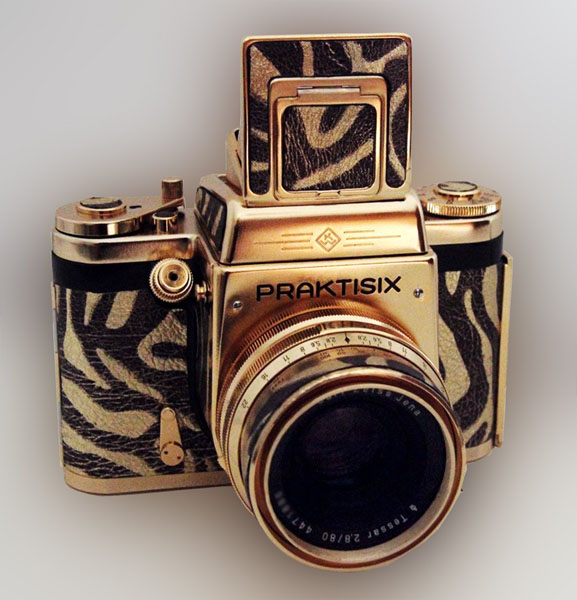
What is it? Read on to find out!
[gp6_02s.jpg]
The Pentacon Six System
Pentacon in Italy

What is it? Read on to find out!
[gp6_02s.jpg]
| We have described
elsewhere a carefully-prepared version of the Pentacon
Six that was sold in Italy. (See here.) Cameras
from the Soviet block were exceptionally common in
Italy. Why was that so? I owe the
following information to an Italian visitor to this
website. Here is what he wrote: Cameras and photo equipment from the "Eastern Bloc" in Italy “The presence of so many cameras and photo equipment from the "Eastern Bloc" in Italy, has a simple explanation. Italy had the biggest and best organized Communist Party outside the USSR and many Italian firms had commercial relationships with the Soviet Union and the DDR. The "FIAT" automobile company, opened a giant production plant in Togliattigrad and the Soviet government paid its part with machinery, tools and... optical equipments/cameras. The "Olivetti" company of Ivrea, Piedmont, (once, famous producers of typewriting and calculating machines) received most of the payment for providing USSR with its products, with cameras and lenses. So, Olivetti opened a Company in the late '60s, called "F.O.S." (Foto Ottica Sovietica = Soviet Photo Optics), with a huge network of shops and assistance laboratories, operating a strong advertisement and a politics of fair prices and discounts to students, young people and workers. In the same time, another firm (Fotoexakta of Turin, property of Messrs. Winkler), imported the Exaktas and in the same time the products of the Pentacon/Zeiss Jena factories. The "FOS" company was too hugely organized for the actual market of Soviet optical products and, once reduced its size, it renamed itself "Antares"; "Atemsa" and perhaps another name, until the Cattaneo Company of Genoa stopped in 1979 being representatives of Leica, took that of the Soviet and DDR optics with the name of "Ing. Ippolito Cattaneo - Genova"; then "Pentacon Italia" and "Exakta Italia" (the former, represented the products of Pentacon and CZ-Jena; the latter, represented Soviet photo-optical equipment only). The collapse of the DDR and of the USSR were also the end of these two companies, re-united under the name of "Investimenti Cattaneo", representing what was still produced by Russian/Ukrainian companies. This is a resumée of how Soviet/DDR camera and lenses found their "official" market in Italy. As you can imagine, lots of USSR equipment came to Italy via-emigrées, tourists, sailors, exchange students, etc., especially during Gorbachev's "Glasnost'" years. Now, in the Italian community of film camera users, whoever carries a Pentacon Six or a Kiev-60 is ironically regarded, or -often- these cameras are just despised. As said, I'm proud of my Pentacon Six outfit. In 1999, I used it along with a Kiev-88, during an archaeological excavation, where I was in charge of the photographic documentation. No one of the State Officials supervising the works had anything to say against my negatives and dias. The Swiss Connection (in Italian) Another curious information: in Switzerland, Messrs. Bernasconi, De Simone and Vio published in the mid-'80s a fine book in Italian: "Il Manuale della Pentacon Six TL e dei suoi accessory". The original edition is difficult to find now, but the book can be downloaded as a .pdf here: http://digilander.libero.it/fiorenzo_fotografia/ .” Gold cameras Other great manufacturers, such as Hasselblad and Rollei, produced gold-plated cameras to celebrate milestones in their achievements. In contrast, the camera manufacturers in Dresden were under the control of the communist ideology and dictatorship imposed by the Soviet Union. So their economic, political and cultural situation did not lend itself to such ostentation. It was in this environment that an enthusiastic Italian collector of KW and Pentacon cameras took the initiative and had some of them gold-plated, himself. He was no doubt proud of them, proud to own them, and justly so! Here are some more pictures of two of these cameras. The Praktisix: a superlative medium format camera The first medium format SLR camera in the world with fully automatic aperture control, with the whole aperture mechanism inside the camera. The Praktisix also has shutter speeds from 1 sec to 1/1000 sec plus B, flash synchronisation, interchangeable lenses, viewfinders and focussing screens, a rapid-change bayonet lens mount, fast-wind lever, built-in delayed action, angled shutter release to steady the camera and so give sharper pictures, a wide range of lenses from Carl Zeiss Jena and Meyer-Optik Görlitz and accessories for every conceivable photographic application. Such was the Praktisix that first became available in 1957. It was worth shouting about and one of them surely deserved to be gold-plated! |
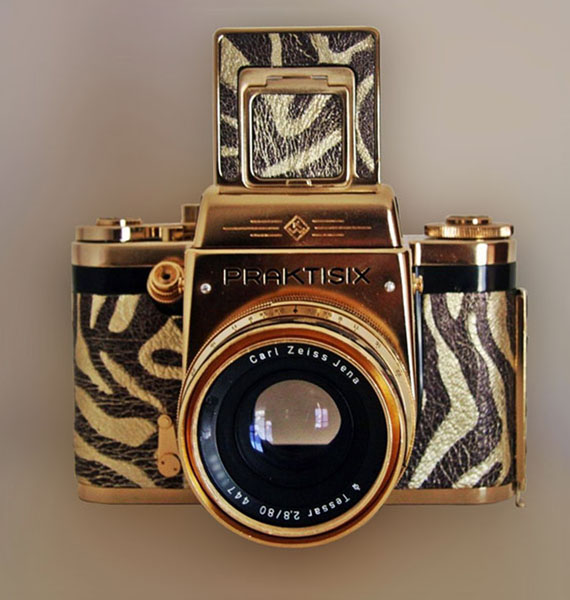 [gp6_01s.jpg] |
 [gp6_03s.jpg] |
Pentacon 35mm
cameras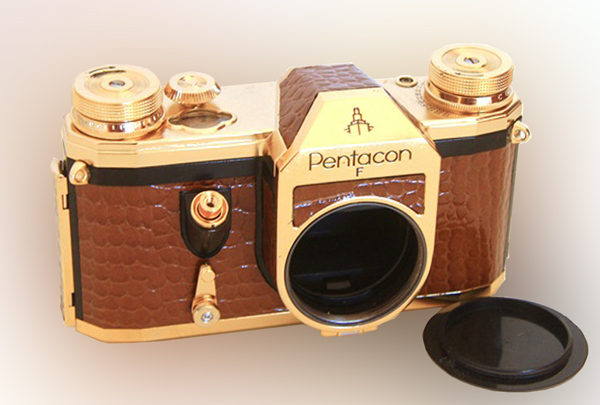 [pentF_front.jpg] The original name of this camera was the
Contax S, the "S" standing for the German word
"Spiegel", "mirror", for it was the first post-war SLR
version of the prestigious pre-war Contax 35mm camera,
made, like it, in Dresden. The Contax S
incorporated further technical innovations as well as
its mirror: a built-in pentaprism that presented an
image that was upright and the right way round, unlike
images of other SLRs of the period, where the image on
the focussing screen was laterally reversed (the left of
the subject appeared on the right of the screen and vice
versa).
Like the Praktisix shown above, this particular Pentacon camera was gold-plated in Italy. |
 [pentF_bks.jpg]
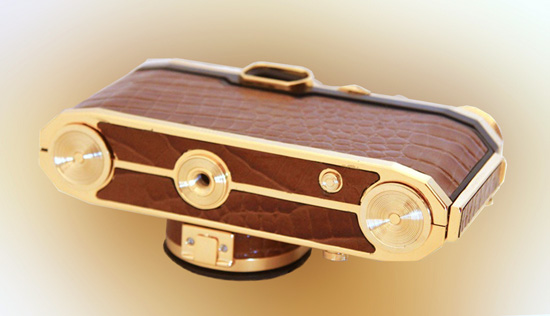 [pentF_bs.jpg] |
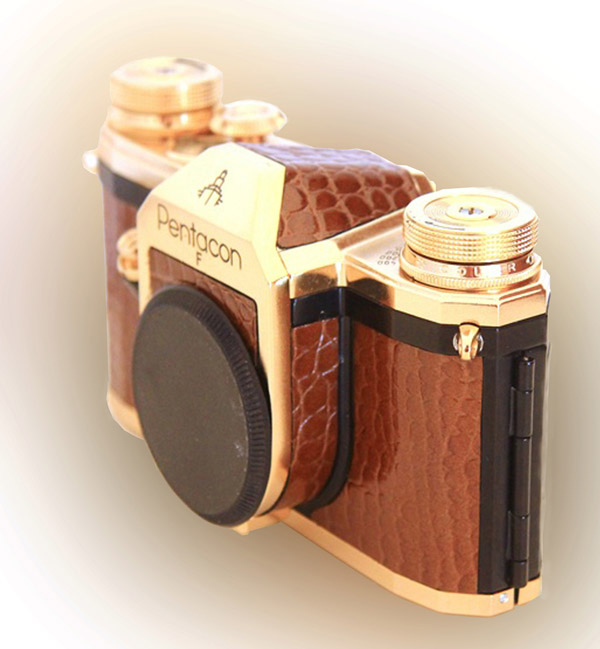 [pentF_lss.jpg]
|
| On the back of the camera, one can see the
slider, just to the right of the viewfinder, that changes
between the slow-speed range and the high-speed range.
The shutter speeds are changed via the mushroom-shaped knob
slightly to the right of it on the top plate. Like the
pre-war Contax II, the Contax S, which was later renamed
Pentacon, has a fold-down tab or foot just below the lens
mount, to enable the camera to stand solidly and
horizontally on a flat surface, without falling forward onto
the lens. This tab can be seen, folded flat, on the
picture of the underside of the camera. Such attention
to detail was both practical and brought much satisfaction
to users. For more information on the pre-war Contaxes, see here. For information on the Contax S, see here. On the Pentacon version of these cameras, see here. |
To go to the beginning of the history section, click here.
© TRA October 2015